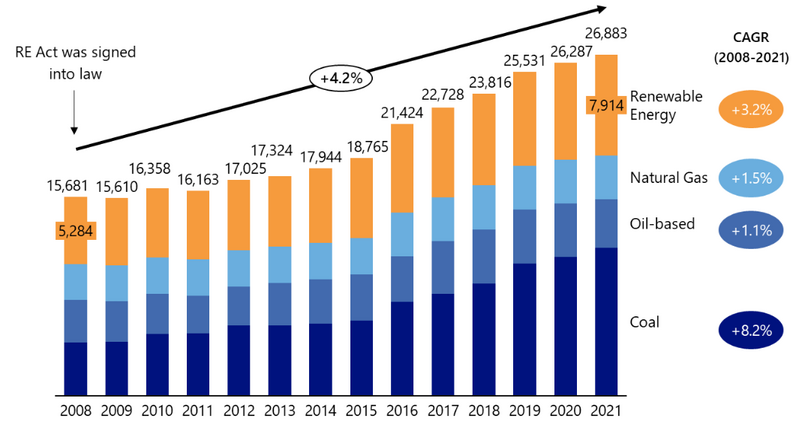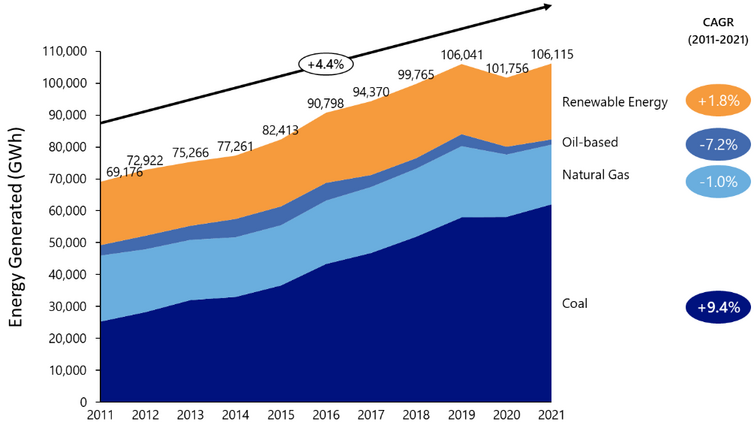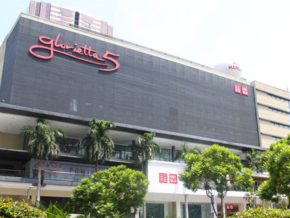Making the Renewable Energy Switch through the Green Energy Option Program
Energy Situation in the Philippines and the NREP
The Philippines continues to push for renewable energy sourcing to lower fossil fuel dependency and to increase energy security. Since the passage of the Renewable Energy Act of 2008 (RA 9513), the installed generating capacity of renewable energy in the Philippines has steadily risen from the time that the RE Act was signed up to the present day at a rate of 3.2% from 2008-2021, or from 5,284 MW in 2008 to 7,914MW in 2021. A comparison of installed power generation capacity in the five major ASEAN countries shows that the Philippines has the second highest ratio of renewable energy after Vietnam.

Installed generating capacity by type (in MW from 2008-2021) / IMAGE from Department of Energy
 Generation Capacity and Power Generation of major ASEAN countries / IMAGE from IRENA, Department of Energy
Generation Capacity and Power Generation of major ASEAN countries / IMAGE from IRENA, Department of Energy
Power generation has been growing with an average growth rate of 4.4% as the growth of the Philippine economy is linked to more electricity demand. The power generation data by source shows that coal-fired power is still the largest source for electricity with an average growth rate of 9.4%. Despite the policy statements of the previous administration under President Rodrigo Duterte in 2020 to not accept new coal fired power facilities, the rise of coal-fired power plants was due to the commissioning of previously approved coal power facilities. Coal-fired power plants have been developed and dominantly used in the country due to affordable fuel cost and stable supply of coal, and those power plants have been filled the gaps of energy demand of this growing country. However, the country currently faces rising coal prices and global trends to achieve carbon net-zero by 2050.
 Gross power generation of the Philippines from 2011-2021 / IMAGE from Department of Energy
Gross power generation of the Philippines from 2011-2021 / IMAGE from Department of Energy
Dependence on coal-fired power could change due to the initiatives set by the Philippine Department of Energy to promote clean and indigenous energy sources such as traditional renewable energy sources (e.g., wind, solar, hydro, geothermal), as well as advanced energy systems (e.g., microgrids, battery storage). According to the Philippine Energy Plan for 2020-2040, the Philippine Government committed to increasing the share of renewable energy into the national electricity mix of 35% share by 2030 and looking further at achieving greater than 50% share by 2040. The overall strategy involves approving more renewable energy applications on the supply side and promoting the use of renewable energy on the demand side.
GEOP to promote RE
One of the initiatives that are directly impacting consumers of electricity, particularly the ones coming from the commercial and industrial sectors of Luzon and Visayas, is through the Green Energy Option Program (GEOP). The general idea of GEOP is that with the high energy demand of a company, it may have a decision to switch from the traditional electricity mix to 100% renewable energy. This would then create more demand for renewable energy on the grid and help accelerate the demand for RE-based systems. Specifically, a consumer in the Luzon and Visayas can decide to join the GEOP if:
• A consumer would have a monthly average peak demand of ≥ 100 kW and above for the past twelve (12) months, or
• New consumers (less than 12 months) would have an:
◦ Estimated monthly average peak demand of ≥ 300kW for the next 12 months; or
◦ Estimated monthly average peak demand from 100kW to 300kW for the next twelve (12) months and has a registered historical monthly peak demand of at least 100kW for three (3) consecutive months.
Note that this only refers to consumers that own facilities that contain these provisions, and not consumers that are leasing or renting a facility. Also, Mindanao consumers could not participate in the program at this time due to the absence of the Wholesale Electricity Spot Market in the area.
Even before the GEOP was implemented, large consumers of electricity were able to purchase renewable energy through the Retail Competition and Open Access (RCOA) program, but only those with a monthly average peak demand of 500 kW or more were able to use this program. Under the GEOP’s participation conditions, the monthly average peak demand is set lower, allowing more consumers to purchase renewable energy. In addition, under the Renewable Energy Act of 2008, electricity derived from renewable energy is exempt from the 12% VAT tax, which is an incentive for consumers to avoid the VAT that used to be charged on the generation cost.
NRI Manila, through its Sustainability Service components, is happy to help companies in looking into GEOP and other initiatives for decarbonization and clean energy with its subject matter experts and consultants in the Philippines and across the world.













